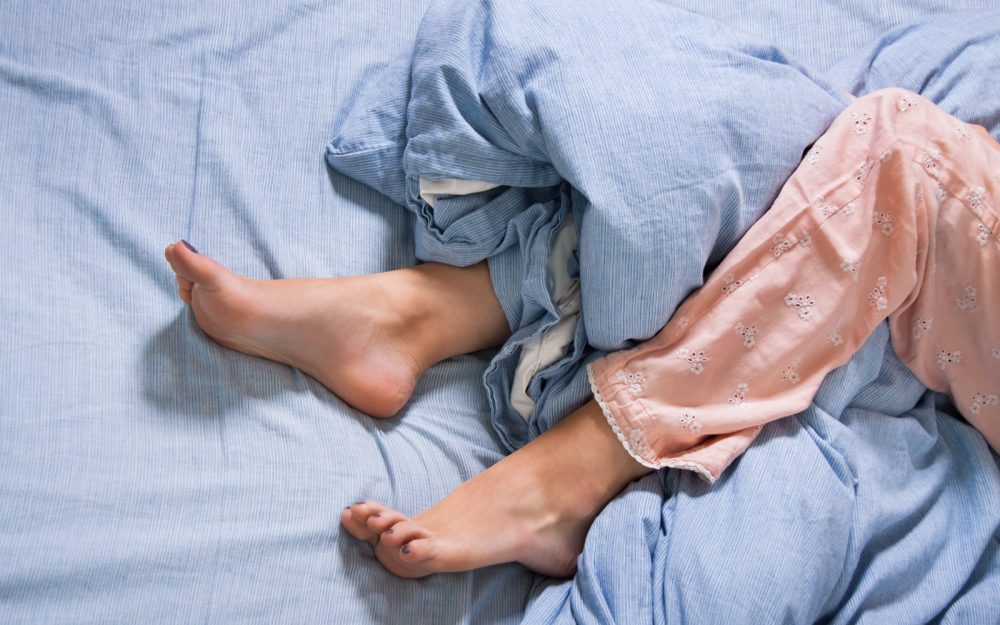
Restless legs syndrome (RLS) is a sleep disorder in which a person has unpleasant feelings or sensations in the legs. These feelings are described as creeping, crawling, tingling, pulling, or painful. While these sensations happen most often in the calf or lower leg area, they can be felt anywhere from the ankle to the upper thigh. RLS symptoms can occur in one or both legs and can also be felt in the arms. These symptoms occur most often when lying down, but can also occur when sitting for long periods of time, such as at a desk, riding in a car, or watching a movie.
People with RLS talk about having an irresistible urge to move the legs. Moving the legs, walking, rubbing or massaging the legs, or doing knee bends can bring relief, at least for a short time.
There are 4 characteristic features in restless legs syndrome. These include:
- An irritating, non-painful sensation in your legs that gives you an overwhelming urge to move your legs. Occasionally, this sensation also occurs in the arms.
- Symptoms occur (or are worse) when you are resting. They improve when you move your legs around.
- Symptoms are worse from evening onwards, especially when you lie down, but you don’t have to be in bed or going off to sleep.
- Little movements of the toes, feet or legs may be visible when you rest, which may look like nervous fidgeting.
Causes of Restless Legs Syndrome (RLS)
RLS is said to be idiopathic, meaning without a known cause.. For about half of all RLS cases, there is a family history of the condition. People who have RLS in the family tend to be younger when symptoms start and develop symptoms slowly.
RLS is thought to be related to the following factors or conditions:
- Some women get RLS during pregnancy, especially in the last 3 months. But the symptoms usually go away about 4 weeks after having the baby.
- People with anemia (low iron levels) may be more likely to get RLS. Once low iron levels or anemia is corrected, symptoms can lessen.
- Chronic diseases such as kidney failure,diabetes, Parkinson’s disease, and peripheral neuropathy (loss of feeling or numbness in the hands and feet) may be linked to RLS.
- Stress, diet or other environmental factors may play a role for some people.
Symptoms of RLS
RLS symptoms are not the same for every person. They range from uncomfortable to painful and can vary in frequency. A person can have periods when RLS does not cause problems, but the symptoms usually return. Another person can have severe symptoms every day.
Common symptoms of RLS include:
- Unpleasant or uncomfortable feelings or sensations in the legs often described as creeping, crawling, tingling, pulling or painful, often producing an irresistible urge to move the legs. These feelings most often occur deep inside the leg, between the knee and ankle. While rare, they can also occur in the feet, thighs, arms, and hands. Most of these feelings involve both sides of the body, although they can happen on just one side of the body.
- Leg discomfort that occurs and gets worse when lying down or sitting for long periods of time. Long car trips, sitting in the movies, long-distance flights, and having a cast on can trigger RLS.
- Symptoms that happen and are worse later in the day, evening, and during the night.
- The need for constant movement of the legs (or other affected body parts) to lessen discomfort. People may pace the floor, move their legs when sitting, and toss and turn in bed.
- Having leg and sometimes arm movements when sleeping that you can’t control.
- Trouble falling asleep or staying asleep.
- Sleepiness or tiredness during the day.
Certain medications, such as drugs for nausea, seizures, and psychosis, as well as some cold and allergy medicines, may make symptoms worse. Talk with your health care provider if you are taking any prescription or over-the-counter medicines.
Diagnosis
There are no tests for RLS. It can be hard to diagnose and is easily confused with other conditions. When someone with RLS goes to see a doctor, there is often nothing wrong that the doctor can see or detect with a physical exam. Diagnosis therefore depends on what a person describes to the doctor. To help make a diagnosis, the doctor may ask about all current and past medical problems, family history, and current medications. A complete physical and neurological exam may help identify other conditions that may be linked with RLS, such as nerve damage (neuropathy or a pinched nerve) or abnormalities in the blood vessels. Basic lab tests may be done to assess overall health and to rule out anemia.
| The International Restless Legs Syndrome Study Group has established the following clinical criteria for diagnosis of RLS:A compelling urge to move the limbs. Motor restlessness; for example, floor pacing, tossing and turning, and rubbing the legs. The symptoms may be worse or exclusively present at rest, with variable and temporary relief by activity. Symptoms are worse in the evening and at night. |
Treatment Options
There is no cure for RLS. Sometimes RLS can be controlled by diagnosing and treating an underlying condition, such as peripheral neuropathy or diabetes. Treating the underlying disease can relieve many of the symptoms of RLS.
For people who have RLS with no diagnosed cause (like an underlying disease), treatment is focused on symptom relief. For those with mild to moderate symptoms, lifestyle changes are often suggested including:
- Reducing or stopping use of caffeine, alcohol, and tobacco products
- Taking supplements to increase iron, folate, and magnesium in the body
- Developing and keeping a regular sleep schedule
- Getting moderate exercise
- Taking hot or cold baths, rubbing or massaging the legs or other affected body parts, or using a heating pad or ice pack.
Health care providers may prescribe medicine for symptom relief. Three types of drugs are most often prescribed:
- Benzodiazepines – these drugs depress the central nervous system and allow people to sleep more, despite the RLS symptoms. They should not be used by people with sleep apnea (a person stops breathing on and off during the night).
- Dopaminergic agents – are drugs used to treat Parkin son’s disease. They have been shown to reduce RLS symptoms and nighttime leg movements.
- Opiods – such as codeine, hydrocodone, oxycodone, propoxyphene, and ramadol. They are painkillers and relaxing drugs that can sometimes help people with severe RLS symptoms.
- Iron (ferrous sulfate), which is used in patients with serum ferritin levels of <50 mcg.
- Clonidine may be useful in hypertensive patients.
Disclaimer
The Content is not intended to be a substitute for professional medical advice, diagnosis, or treatment. Always seek the advice of your physician or other qualified health provider with any questions you may have regarding a medical condition.


